After several trips to Bulgaria, I’ve got the scoop on the yummiest food you have to try. Trust me, you won’t want to leave without diving into the variety of traditional Bulgarian food. From the unique flavors of Bulgarian cheese to my favorite Bulgarian foods like banitsa and kavarma, there’s a whole world of different dishes waiting.
Read on for my Bulgarian food guide for so many ideas on what to try in Bulgaria.

Skip Ahead To My Advice Here!
What To Try In Bulgaria
Bulgaria, a hidden gem in Southeastern Europe, offers an untouched slice of the Black Sea coast, a place in the Bulgarian heart. Surrounded by less-visited countries like Romania, Serbia, and North Macedonia, its cuisine is a treasure trove of Balkan flavors, enriched by neighbors like Greece and Turkey.
I’ve been to Bulgaria several times, and I can attest that Bulgarian food is tasty and Bulgarian cuisine boasts unique dishes reflecting a long and vibrant history.
Despite its modest size, Bulgaria presents a culinary consistency across its regions, with special treats in the Rhodope Mountains and along the Black Sea coast.
If you’re new to the culinary delights of this country, you’re in for a treat. Bulgarian cooking traditions are diverse, emphasizing organic and locally sourced ingredients. Many eateries even grow their own veggies, and they love putting cheese on top to enhance the flavor.
Whether you’re into meaty feasts like the cured Bulgarian sausage, vegetarian dishes with cabbage, or those tasty Bulgarian pancakes, Bulgaria has something to offer.
Let’s discover what food they eat in Bulgaria!
Traditional Bulgarian Food
 Here are the most popular traditional dishes in Bulgaria.
Here are the most popular traditional dishes in Bulgaria.
Traditional Bulgarian Appetizers, Snacks & Dips
1. Kiselo Mlyako – Bulgarian Yoghurt
Bulgarians may consume more yogurt than anywhere else in Europe, and it has to be one of the foods in Bulgaria you don’t miss. Bulgaria offers visitors a truly unique yogurt variety known as kiselo mlyako, which contains two different types of healthy probiotic bacteria, including lactobacillus bulgaricus and streptococcus thermophilus.
While kiselo mlyako’s bacteria names may be hard for your mouth to handle, the yogurt goes down easy.
Kiselo mlyako is a thick yogurt with a slightly sour flavor but is generally mild and has a pleasant creamy finish. It is definitely good enough to have by itself. Still, many use kiselo mlyako as the yogurt of choice for numerous other Bulgarian dishes, some of which are mentioned below. You’ll find yogurt in soups, desserts, salads, and dips.
2. Lyutenitsa – Bulgarian Pepper & Tomato Relish
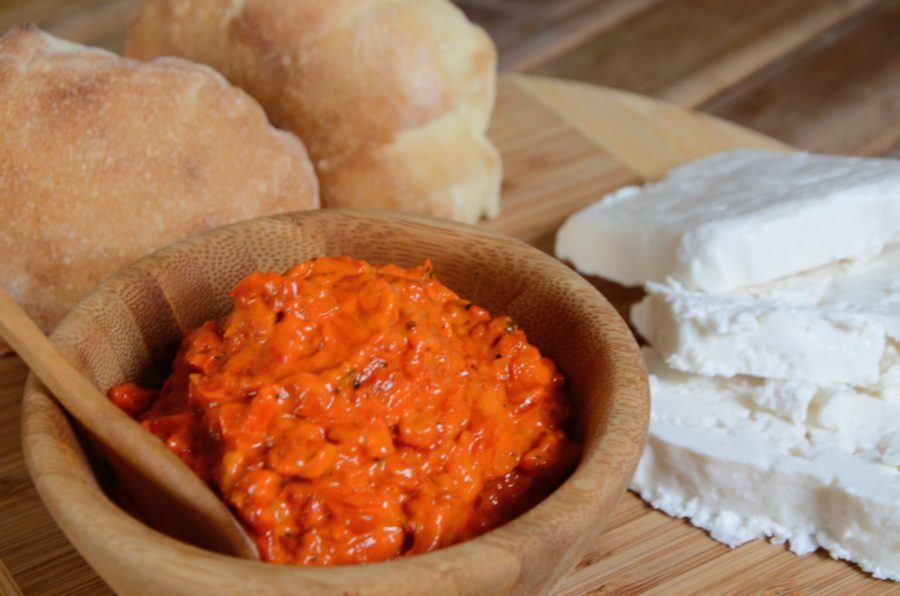
You could compare lyutenitsa to chutney, which is commonly found in Bulgaria. With eggplant, tomatoes, garlic, carrots, peppers, and oil, this is often served on the side of most meals and as a meze.
Fish And Meat Dishes In Bulgarian Cusine
3. Sudjuk – The Ultimate Bulgarian Sausage
Packed with tons of protein and versatile uses, sudjuk is a fermented sausage that is a widely popular part of the Balkan region diet. You can liken it to salami, with its bit of a bite coming from spices like red and black pepper alongside cumin and sumac.
You’ll most often see sudjuk made using beef, pork, or lamb; however, some recipes call for horse meat. Many people choose to pan-fry or grill sudjuk and then enjoy it alongside their eggs for breakfast or as a topping on a pizza for lunch or dinner. Pair dishes made with sudjuk with an excellent Bulgarian red wine or rakia fruit brandy for the finest experience.
4. Lukanka – Bulgarian Dried & Spiced Sausage
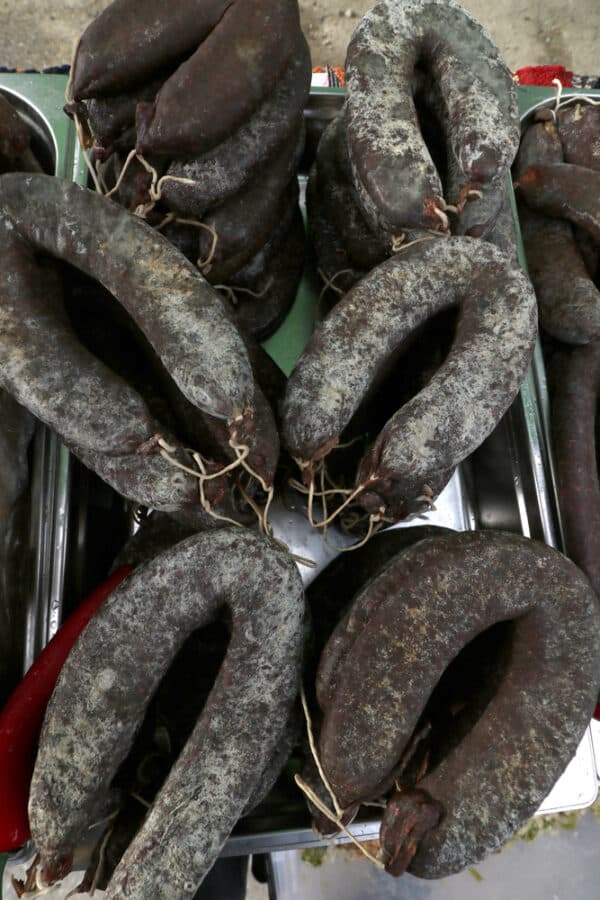
Not to be outdone in the cured meat section, lukanka may top sudjuk in terms of popularity in Bulgaria. Lukanka can be recognized by its flattened cylindrical shape, which comes about during the drying process, taking up to two months or more. Similar to sudjuk, it presents a bit stronger flavor and has a slightly more pungent smell.
Lukanka is popular as an appetizer before you settle into your main Bulgarian meal.
The sausage often contains pork or veal meat housed inside a dried cow intestine casing. Similarly spiced to sudjuk, you often see a few more spices added, such as nutmeg, paprika, and coriander. You’ll find some of the finest lukanka in the Balkan Mountains of central Bulgaria.
5. Kufte – Bulgarian Meatballs

Another ubiquitous main dish is flat meatballs that are often cooked on the barbeque. Kufte are usually made of beef, but you’ll also find veal or pork options. The meat is seasoned and frequently contains red pepper flakes for extra spice.
6. Lozovi Sarmi – Grape Leaves Stuffed With Rice & Meat
Somewhat resembling an odd-looking, uncut black nori seaweed-wrapped sushi roll, lozovi sarmi uses the same concept of wrapping ingredients inside a casing. In the case of lozovi sarmi, the casing is made of fresh grape leaves that have been flash-boiled in salty water. You then have the choice of creating vegetarian lozovi sarmi packed with ingredients like white rice and onions or ones that add mincemeat to some Bulgarian recipes.
Lozovi sarmi make great appetizers and can be served hot or cold. They are best served with yogurt as a dipping sauce, and drinking mineral water with them enhances the flavors. An alternative to using grape leaves for the casing is pickled cabbage.
7. Bulgarian Moussaka – Layered Casserole
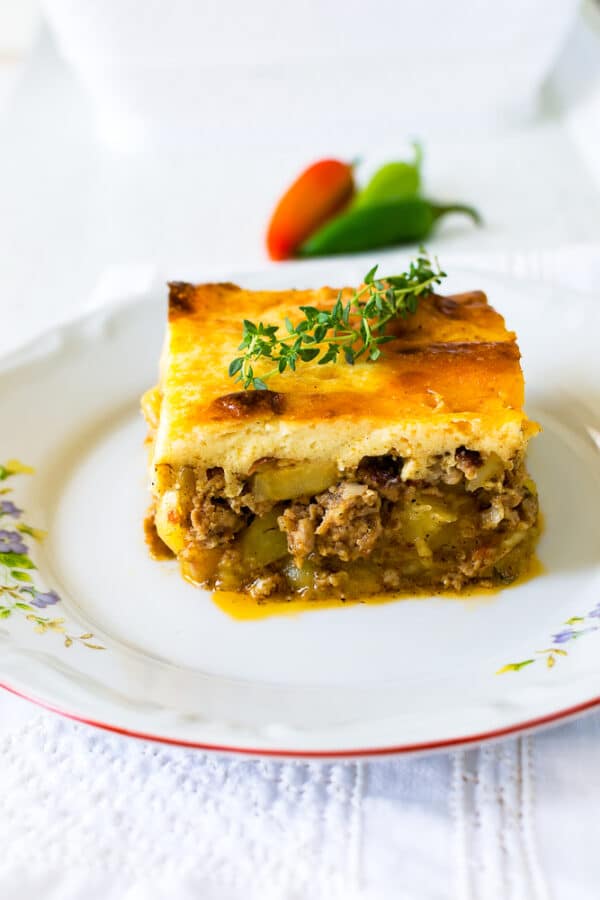
It is jokingly said in Bulgaria that a suitable partner must know how to make good Bulgarian moussaka. Moussaka may be considered more Greek, but the Bulgarians have their own unique recipe, which is adored throughout the country. Bulgarian moussaka substitutes the traditional eggplant found in the Greek variety with potatoes and contains minced or ground meat, eggs, and sometimes mushrooms.
This traditional Bulgarian food is easy to make and is incredibly delicious. Some recipes call for a topping of yogurt for a bit of a tangy flavor, while others choose to top their moussaka with cheese.
8. Kavarma – Bulgarian Stew
It is a delicious and thick stew that is simmered to ensure the meat falls apart in your mouth. Often cooked in a clay pot, kavarma is usually made with beef, but you can also find pork and chicken options. In addition, this stew includes peppers, tomatoes, onions, mushrooms, leeks, and carrots, and it is often thickened with wine.
9. Sarmi – Stuffed Cabbage Rolls

This is a dish made of stuffed, rolled vine leaves or cabbage. Inside, you’ll find minced meat and rice, and it’s then poached and served with a thick tomato sauce over the top. You’ll find many variations of sarmi around this part of the world, but in Bulgaria, they’re ubiquitous.
10. Supa Topcheta – Meatball Soup
You’ll find supa topcheta served during the winter as a warming and comforting soup with meatballs, carrots, onions, and celery. This is quite a thick soup and is usually served with fresh bread.
11. Shkembe Chorba – Tripe Soup
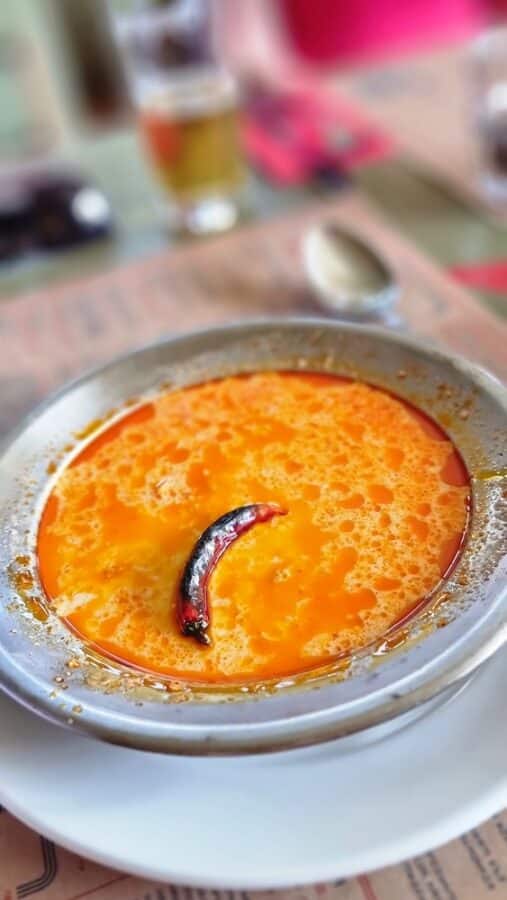
While most foods in Bulgaria are pretty tame, shkembe chorba may take a bit more courage for some to sample. The issue lies with the soup’s main ingredient, tripe, which, if you are in the know, is the stomach lining of an animal.
It is boiled for hours and then diced before being added to the soup and combined with fried paprika, hot red pepper, and chili. Bulgaria’s recipe usually calls for the tripe of a cow or sheep.
Because the soup can have quite a kick in terms of being spicy, this is another reason you may need the courage to order the soup if you tend to favor bland dishes. The often added garlic gives the soup an even greater aroma but can be avoided if you like to maintain a fresh breath.
The traditional Bulgarian soup has even become a so-called hangover cure for many. And if you’re looking to be even more courageous, some varieties of shkembe chorba substitute the tripe for intestines.
Brands We Use And Trust
Vegetarian Bulgarian Food Classics
12. Bulgarian Stuffed Peppers – Palneni Chushki Recipe
Palneni Chushki, or Bulgarian stuffed peppers, are common among Bulgarians and often made for Christmas. Palneni Chushki can be made without meat, though many other versions of Bulgarian stuffed peppers have meat and other vegetables.
Stuffed peppers are very popular in Bulgaria, and it is one of the many Balkan countries with a stuffed pepper recipe – you can try our vegetarian-friendly recipe below.
13. Tarator Soup – Cold Soup Of Cucumbers

Moving on to the heavy hitters of traditional Bulgarian cuisine, tarator soup is a standout side dish and easily one of the most famous Bulgarian dishes. You’ll quickly discover that this cold soup is listed on nearly every Bulgarian menu.
A ubiquitous sight during the warm summer months, this chilled soup is simple, light, and very refreshing. Commonly served as a first course, tarator soup may be your initial introduction to authentic Bulgarian cooking when you arrive.
Traditional tarator soup usually contains a blend of the beloved unique Bulgarian yogurt, chopped dill, cucumbers, sunflower oil, and maybe some garlic. Cold water or ice cubes are added to make it all that more refreshing.
Some varieties may see the soup topped with walnuts for a bit of a crunch, and there’s a salad version of the soup that omits watering down the yogurt.
14. Mish-Mash – Salad
This type of salad consists of eggs, cheese, and vegetables. The cheese is usually something like feta, but the Balkan version! You’ll usually find onions, peppers, and tomatoes in a traditional salad, but you may also find extras such as carrots and eggplant.
15. Shopska Salata – Shopska Salad

While tarator soup may be loved nationwide, many regard shopska salata (salad) as the Bulgarian national dish; it has rapidly become a national culinary symbol of Bulgaria since it was created in the 1950s. Every color of Bulgaria’s flag is displayed in the dish through its ingredients.
The salad, which has won a Taste of Europe contest in the past, usually contains a mix of cucumbers, tomatoes, onions, bell peppers, olive oil, and grated white sirene cheese, which is said to be the key ingredient to giving the salad its unique flavor.
Like tarator soup, this cold salad is frequently served during summer. This is easily the most recognizable dish in Bulgaria, regardless of which variety you choose. You may find a few variations being offered around the country, some of which may contain extras like mushrooms or eggs.
If you travel around the Balkans, you will notice this Bulgarian salad is also found in Serbia, North Macedonia, and a few other countries.
16. Snezhanka – Bulgarian Yogurt & Cucumber Salad
This is another white salad with yogurt, garlic, cucumber, salt, dill, and olive oil. It’s very similar to haydari in Turkey or tzatziki in Greece.
17. Bob Chorba – Bulgarian Bean Soup Cooked In A Clay Pot

Bob chorba is another Bulgarian meal prominently made to be vegetarian. Bob chorba is a white bean soup that is often cooked and served in a clay pot. While many different vegetables can be added to the soup depending on your tastes, it’s common to see peppers, carrots, onions, and tomatoes. Much like patatnik, many bob chorba recipes also call for a bit of mint.
In addition to being vegetarian, most bob chorba varieties are vegan and gluten-free, making them suitable for nearly everyone. That is probably why this dish is considered the national dish of the mountains in Bulgaria. You can, of course, add a bit of pork or sudjuk sausage if you like your meat or want some added protein.
18. Petroselino – Parsley Meatballs

We loved these at Raketa in Sofia. These “meatballs” have no meat. They are made from parsley, eggs, cow cheese, yellow cheese, and flour. We had them served with a mayonnaise-garlic sauce topped with fresh dill.
19. Sezonni Supi – Seasonal Soups

While traveling in Bulgaria, we loved that traditional Bulgarian restaurants made soups from seasonal ingredients. Like this one made from broccoli. Plus, we had at least three others on a one-week trip there last year.
Bulgarian Traditional Pies
20. Banitsa – Yummiest Bulgarian Breakfast
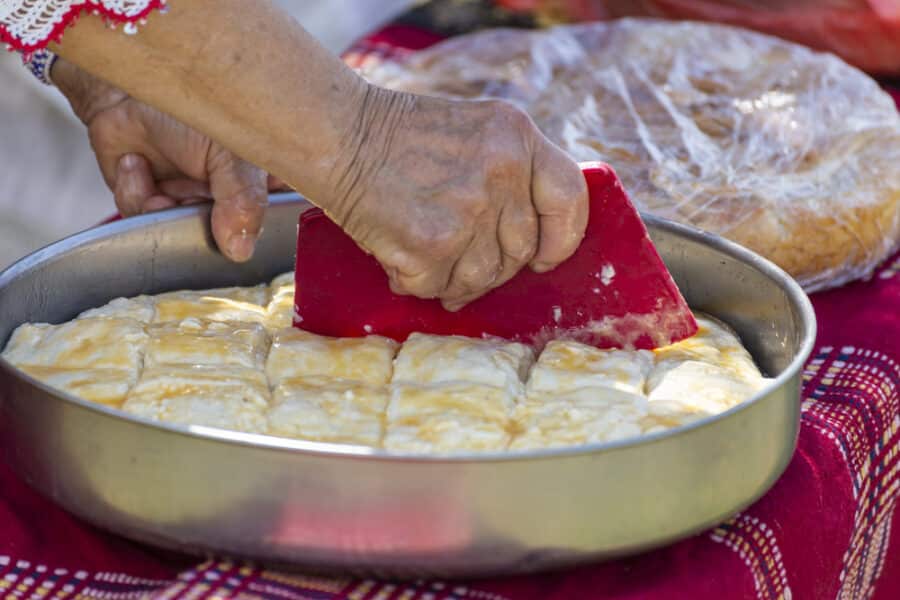
Banitsa, sometimes written as banitza, is one of Bulgaria’s most famous foods and one of its most versatile. This baked pastry can be served hot or cold and can be made to be sweet or savory – we all liked the sweet banitsa best.
Banitsa comprises layered sheets of buttered filo pastry containing eggs and, most commonly, a white cheese known as sirene as a filling. It is a common Bulgarian breakfast item, but the sweeter varieties filled with ingredients like apples, pumpkin, or walnuts are often enjoyed as popular Bulgarian desserts.
While this may be a rare high-calorie Bulgarian cuisine item, you can opt for varieties filled with spinach, onions, leeks, or cabbage as a healthier option. You’ll often see people eating banitsa with a side of yogurt, and during the festive winter season, the pastry usually contains good luck charms or coins.
Bulgarian Desserts
21. Palachinka – Bulgarian Crepes
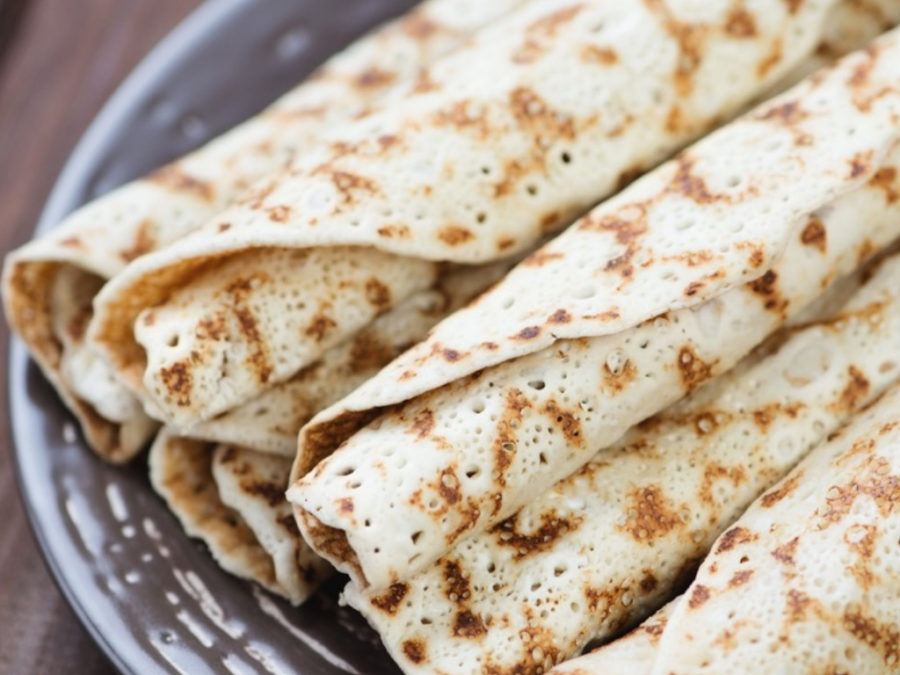
Basically, this is a type of crepe that is filled with honey and butter, rolled, and dusted with powdered sugar.
22. Tikvenik – Unique Bulgarian Dessert
When it comes to dessert, who needs apple pie or carrot cake when you have tikvenik?
This Bulgarian pumpkin strudel offers up just the right amount of sweetness to not leave you feeling like you may get diabetes afterward – ideal for those of us who don’t have a big sweet tooth.
Shaped in a coil, the strudel features flaky filo dough that embraces a concoction of pumpkin, cinnamon, brown sugar, vanilla, and maybe some pecans or walnuts if you’re feeling a bit nutty. Top it off with a bit of orange zest and powdered sugar, and you’re all set.
Bulgarian Drinks
23. Boza – Traditional Fermented Cereal Beverage

On to drinks, boza is a popular malt beverage many Bulgarians pair with their banitsa at breakfast. Made in Bulgaria from wheat and millet, the drink is served cold and offers a sweet and sour refreshing taste. While it does contain a trace of alcohol, you’ll struggle to get intoxicated from its roughly 1% alcohol content. More important than it having alcohol is that it offers up many vitamins.
24. Rakia – Bulgarian Fruit Brandy

Bulgaria’s national drink, rakia, is a far cry from boza regarding alcohol content. Commonly, the drink contains around 40% alcohol, but homemade varieties, which are standard across the country, can have upwards of 50% to even 60% alcohol.
Rakia is served at all kinds of important occasions in Bulgaria, including weddings and funerals, making it undoubtedly the most popular drink in Bulgaria.
So what is rakia? Rakia is a strong fruit brandy most commonly produced from grapes such as muscat or sauvignon blanc grapes, but it can also be made using a range of high-sucrose fruits such as peaches, plums, or apricots. There is even a unique variety of rakia found in the Rose Valley region of Bulgaria, appropriately named rose rakia.
Rakia is an aperitif in Bulgaria, unlike the similar strong drinks of other countries, which tend to take the role of digestive. While it may be often served in a shot glass, it’s important to take things slow and sip rather than down in one gulp. If you are sampling homemade rakia for the first time, you’d be wise to add a bit of water to dilute the alcohol content.
It makes for a great souvenir to bring home from Bulgaria!
25. Bulgarian Beer

You’ve got several Bulgarian beers to choose from; while on our travels, Mr. Chasing the Donkey always gravitated toward the Zagorka Bulgarian lager. The cold beer went well with the meaty dishes he gravitated toward.
Traditional Bulgarian Cuisine From The Black Sea Coast
Here is what to eat in Bulgaria when you’re by the sea:
26. Bulgarian Fresh Fish
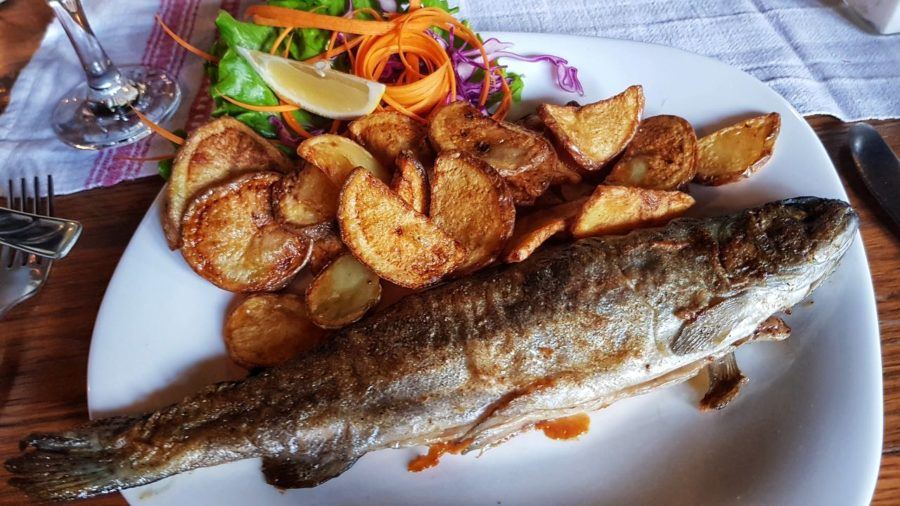
Moving on to the Black Sea Coast, it should be no surprise that seafood is the main feature of local menus. Thanks to Bulgaria’s numerous rivers and lakes, you’ll find a nice sampling of saltwater fish caught just offshore and freshwater fish.
Many fish species are seasonal, so what’s on offer will likely vary depending on your visit. Popular freshwater fish include brown trout, blue and channel catfish, European perch, and common carp, usually baked and stuffed. Popular saltwater fish that find their way onto menus include jack mackerel, whiting, mullet, hake, Black Sea turbot, cod, and European seabass.
You’ll usually find fish fried, baked, or grilled alongside salad or potatoes. However, you may also want to try the popular Ribena chorba, a traditional Bulgarian fish soup. The soup often contains a variety of diced fish or fish heads that swim alongside a gathering of vegetables, including onions, carrots, potatoes, and tomatoes.
27. Fried Sprats
One fish dish that gets a special mention is deep-fried sprats. It’s Bulgaria’s answer to English fish and chips. An order of fried sprats consists of a few dozen small fish belonging to the herring family, which have been deep-fried with salt and garlic powder. You’ll be crunching into the head, tail, and all.
The sprats, or tsatsa as they are known locally, are usually accompanied by a side of french fries and lemon wedges. Fried sprats make the perfect hot summer day snack in Bulgaria.
28. Rapa Whelks

One of Bulgaria’s more exotic traditional foods is the veined Rapa whelk. This marine sea snail may now be the main seafood harvested from the Black Sea, but ironically, the whelks are not native here. Rapa whelks originate from the South China Sea and the Sea of Japan, where it is thought Russian WWII military ships helped the stowaway whelks find a new home in the Black Sea.
The whelk population exploded, so Bulgarians started harvesting them to control their numbers. And, now it’s a Bulgaria traditional food! The currently popular dish along the coast resembles abalone in taste with a texture reminiscent of raw clams. You may find whelks served fried, boiled, and thinly sliced with a white wine sauce or served in a salad.
29. Mussels
The main ingredient in many coastal soups and salads are Black Sea mussels. Like Rapa whelks, they may also be stewed in a white wine sauce. There are numerous mussel farms along the coast. The Dalboka Mussel Farm in Kavarna is the largest and most prominent, which offers a lovely restaurant with exceptional coastal views.
Move This Adventure To Your Inbox & Get An Instant Freebie

No spam. Unsubscribe at any time.
Traditional Bulgarian Dish Options From The Rhodope Mountains Of Southern Bulgaria
30. Kachamak – Cornmeal Or Wheat Porridge Or Polenta
A hearty mountain Bulgarian breakfast packed with energy, the polenta-like kachamak is often just a simple blend of cornmeal, water, salt, butter, and local sirene cheese. Fancier versions may add heated lard, paprika, pumpkin, or walnuts. And, of course, like with many other Bulgarian dishes, it’s not unusual to pair kachamak with a side of yogurt.
31. Patatnik – Bulgarian Potato Dish
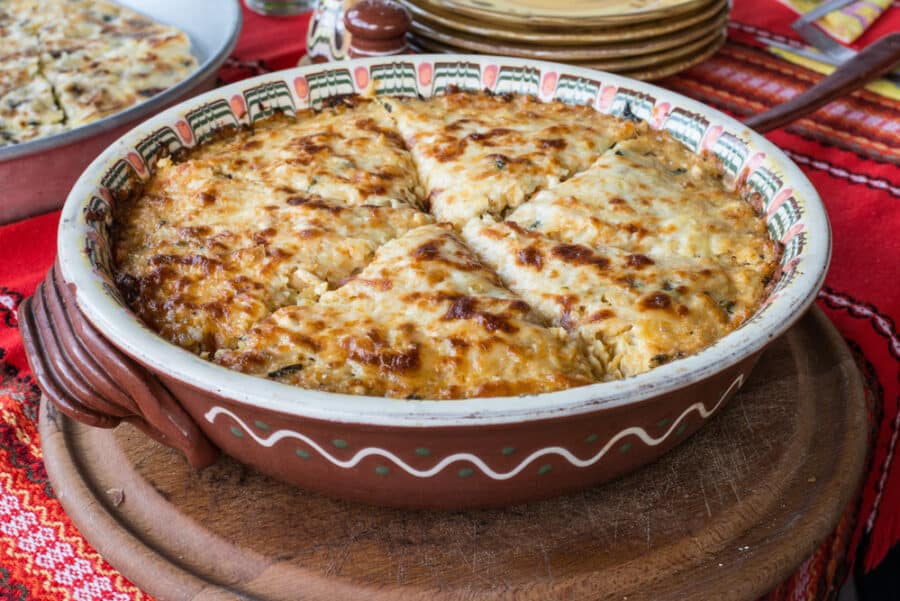
Patatnik is one of Bulgaria’s top comfort foods originating in the Rhodope Mountains. It’s a shredded potato pie typically featuring Bulgarian sirene white cheese, but you may also see it prepared with local grated kashkaval yellow cheese. The dish also features a hint of mild locally grown mint.
The traditional Bulgarian cooking method of patatnik involves slow cooking over an open fire. Still, nowadays, you often see it prepared in a pan on the stove or baked in the oven. It may not be the quickest dish to make, taking around 30 to 40 minutes from start to finish, but the flavor is worth the effort. Some varieties may also include eggs or peppers.
32. Marudnik – Layers Of Phyllo Pastry With A Sweet Filling
The Rhodope Mountains are also home to a unique type of pancake called a marudnik. Made with flour, eggs, baking soda, and yogurt, the dish is eaten as more of a dessert rather than a breakfast item.
Traditionally, marudnik pancakes are cooked on a flat hot stone, but you can prepare them in a pan. Serve them alongside your favorite jam or wild berry preserve, with maybe a bit of powdered sugar for added sweetness.
Bulgarian Food FAQs
What is meshana skara?
Meshana skara is a mixed grill dish in Bulgarian cuisine that typically includes a variety of grilled meats such as kebapche, kyufte, and pork skewers.
What is shopska salad?
Shopska salad is a traditional Bulgarian salad made with chopped cucumber, tomatoes, bell peppers, and onions and topped with Bulgarian white cheese.
What is the significance of shopska salad in Bulgarian food culture?
Shopska salad plays a significant role in Bulgarian food culture as a refreshing and quintessentially Bulgarian dish that is enjoyed as a side or starter in many meals.
What is the symbol of Bulgarian cuisine?
The symbol of Bulgarian cuisine, while not encapsulated by a single dish due to the country’s rich culinary traditions, can often be represented by “Banitsa.” Banitsa is a beloved traditional pastry made of layers of filo dough, filled with a mixture of eggs and cheese, usually Bulgarian white cheese (sirene).
Where can I try traditional Bulgaria?
You can try traditional Bulgarian dishes like meshana skara in restaurants, taverns, and local eateries across Bulgaria, especially in cities like Sofia where traditional cuisine is widely available.
How is Bulgarian white cheese used in classic Bulgarian dishes?
Bulgarian white cheese, also known as ‘sirene,’ is a key ingredient in many Bulgarian dishes, adding a rich and creamy flavor that complements meats, salads, pastries, and more in traditional Bulgarian cooking.
These are just a sampling of the many unique and very delicious Bulgarian meals and drinks you’ll find while traveling throughout Bulgaria. The longer you stay and roam the nation, the more hidden flavors you’ll likely encounter.


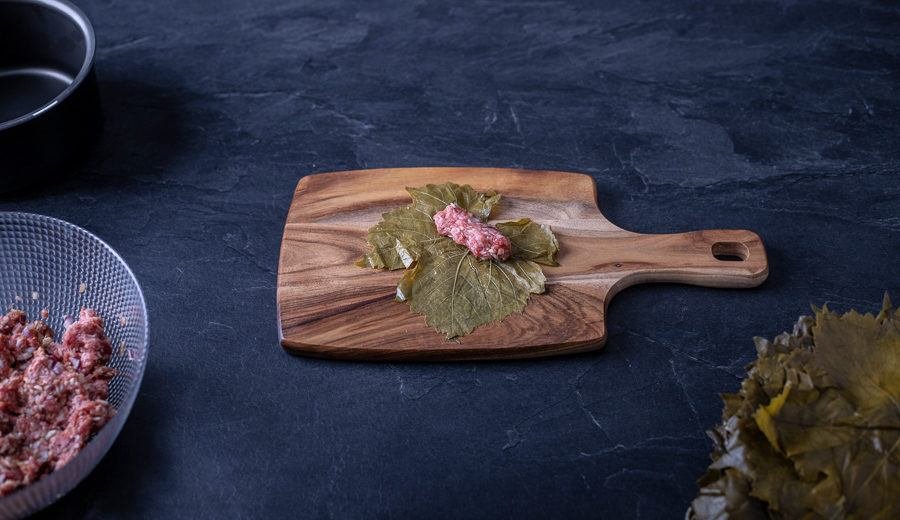
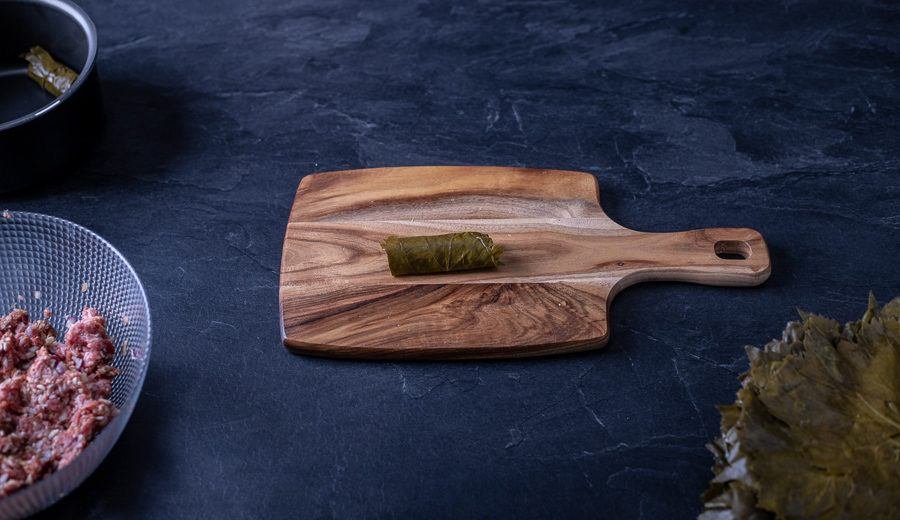
Do you have recipes for any of these by chance?
Not right now, sorry.
What recipes particularly are you interested in,Simona? I may be able to help :)
I truly enjoyed your entry.It is well written and it shows a great deal of knowledge- unlike an article I recently read where the only illustration of Bulgarian cuisine was a picture of Japanese sushi meal!!! You know a lot about our food and my whole family enjoyed reading about the what we grew up with and still cook every day,while living far away from Bulgaria! Thanks!
Thanks for sharing this blog, Keep it up!
Great article just keep on posting this.
I’ve read your blog this is very impressing and informative.
Nice information!
Thank you for sharing such a wonderful reflection on my home; really allowed me to visualize what miss about living in Bulgaria
You are so welcome, we also have recipes if you need those.
Please write more about Bulgaria.
Thanks for such very great information..
thank you for sharing wonderful food
yummy tummy food
Bulgarian desserts are like ours